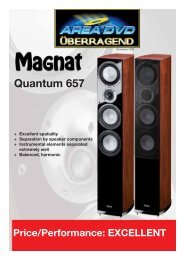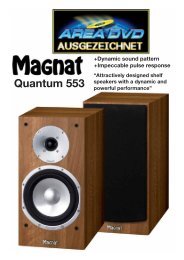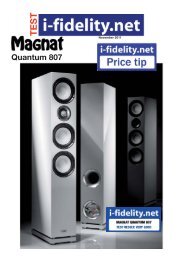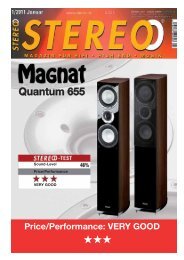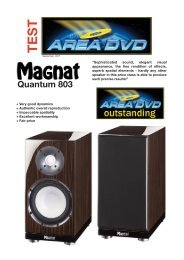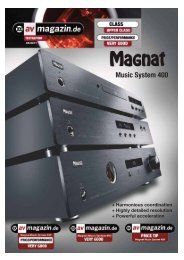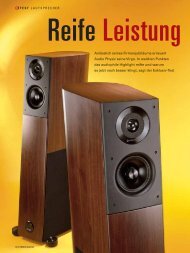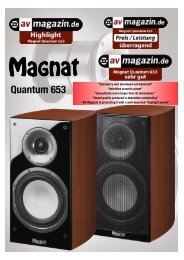An Element of - Audio System
An Element of - Audio System
An Element of - Audio System
Create successful ePaper yourself
Turn your PDF publications into a flip-book with our unique Google optimized e-Paper software.
L O U D S P E A K E R<br />
T E S T<br />
<strong>An</strong> <strong>Element</strong> <strong>of</strong><br />
page 36 STEREO 1/2013
Surprise<br />
<strong>Audio</strong> Physic has pulled out all the<br />
stops by surprising us with its new<br />
Classic 10 and Classic 20 floorstanding<br />
loudspeakers. One highlight<br />
<strong>of</strong> these two models is the fact that<br />
they are both available with a pure<br />
glass surface but their real outstanding<br />
factor is their impressive sound, not to<br />
mention their price.<br />
The inner cabinet <strong>of</strong> the Classic 10 features narrow<br />
gaps (shafts) that act as reflex ports and enable pressure<br />
to escape through the back <strong>of</strong> the loudspeaker.<br />
As I step into the listening room, I see<br />
that <strong>Audio</strong> Physic‘s new Classic 20<br />
model has already been set up and<br />
connected and is ready for its listening test.<br />
<strong>An</strong>d what do I choose to play? The answer:<br />
something well known, something I've already<br />
heard thousands <strong>of</strong> times. The sounds <strong>of</strong> Maria<br />
Pihl’s “Malvina” flow from the slim white<br />
shimmering loudspeakers. The sound<br />
reproduction features a rich, full bass and it<br />
feels like the singer is standing right in front <strong>of</strong><br />
me, live and in person, while swathes <strong>of</strong><br />
synthesized sounds stagger down into the<br />
depths in the background. The sound image<br />
has both form and energy. It is radiant but not<br />
hard and easily fills up the voluminous room,<br />
ticking all <strong>of</strong> the boxes.<br />
<strong>Audio</strong> Physic’s Head <strong>of</strong> Sales Stefan<br />
Dreischärf then asks me: “How much do you<br />
think this loudspeaker should cost?” I walk<br />
around the object in question, observing its<br />
cleanly finished glass surface, which is<br />
smoother than any coating could ever achieve.<br />
The loudspeaker also features high-quality<br />
drivers, for example a wo<strong>of</strong>er located in a side<br />
chamber. These drivers are obtained from the<br />
specialist company Wavecor, which also produces<br />
the drivers used in the top models <strong>of</strong> the<br />
loudspeaker manufacturer from the Sauerland<br />
region <strong>of</strong> Germany. Even the connection<br />
terminal features WBT “nextgen” connectors,<br />
which are the best-sounding option available<br />
and certainly don’t come for cheap.<br />
On the basis <strong>of</strong> its sound and<br />
complexity, I estimate that the Classic 20<br />
costs at least 3500 Euros per pair … and I’m<br />
wrong! The price tag for the glass design,<br />
which is available in black or white, reads<br />
2390 Euros exactly. The loudspeaker is also<br />
available in four veneer designs starting at a<br />
price <strong>of</strong> only 2190 Euros, while its little<br />
sister, which is almost equally ambitious<br />
where its delight in reproducing sound and<br />
taking centre stage is concerned, has an<br />
asking price <strong>of</strong> just 1590 or 1790 Euros.<br />
The next surprise came in the form<br />
<strong>of</strong> the Classic 10. Although its sound in the<br />
lower frequencies was less powerful and its<br />
midrange was not quite as balanced as that<br />
<strong>of</strong> the 20, this loudspeaker did not have to<br />
make much <strong>of</strong> an effort to hit the spotlight in<br />
the large listening room, demonstrating a<br />
similar mellowness to its big sister and producing<br />
a musical sound that was almost even<br />
more punchy and explosive. <strong>Audio</strong> Physic<br />
has certainly made an impressive coup with<br />
its "Classics", especially in consideration <strong>of</strong><br />
the fact they are manufactured at its company<br />
headquarters in the German town <strong>of</strong> Brilon.<br />
Supplied with Two Different Panels<br />
The new product line available from the<br />
company from the Sauerland region <strong>of</strong><br />
Germany also includes the two-way<br />
loudspeaker known as the Classic<br />
Compact (for which prices start at 1290<br />
Euros per pair) and the Classic Center at a<br />
price <strong>of</strong> at least 890 Euros, both <strong>of</strong> which<br />
are available with either a veneer finish or<br />
a glass surface. These solid sixmillimetre-thick<br />
glass panels give the<br />
loudspeakers an unusual design highlight.<br />
They not only look great but also have a<br />
stability that improves the sound without<br />
causing any tonal disturbances because the<br />
fact that they are firmly fastened to the<br />
MDF inner cabinet practically eliminates<br />
the possibility <strong>of</strong> vibrations. As if that<br />
wasn’t enough, according to <strong>Audio</strong><br />
Physic's Chief Designer Manfred<br />
Diestertich, the MDF and glass "sandwich"<br />
is also virtually perfect thanks to the<br />
completely different resonant behaviour <strong>of</strong><br />
the two materials.<br />
<strong>An</strong>other special feature <strong>of</strong> this<br />
product line is the fact that every Classic
L O U D S P E A K E R<br />
T E S T<br />
model is supplied with two different panels.<br />
One <strong>of</strong> these panels perfectly surrounds the<br />
drivers, giving the loudspeaker a technoid<br />
elegance, while the other uses a fabric covering<br />
panel to conceal the drivers. Both <strong>of</strong> these<br />
panels are a perfect fit and give the loudspeakers<br />
a sophisticated appearance that makes it<br />
easy to overestimate their price.<br />
Both <strong>of</strong> the Classics feature base<br />
reflex constructions, with the Classic 20 model<br />
pumping air downwards. The Classic 10 boasts<br />
an ingenious solution that uses narrow gaps in<br />
the sides <strong>of</strong> the cabinet to provide precisely<br />
measured access to the loudspeaker’s external<br />
surroundings. This special trick not only aims<br />
to lead to a more balanced involvement <strong>of</strong> the<br />
room, but also to prevent the escape <strong>of</strong> midrange<br />
frequencies, which can never be fully avoided<br />
in conventional tubes. On top <strong>of</strong> this, we can<br />
also confirm that setting up the loudspeaker<br />
closer to the wall in connection with the<br />
smaller drivers is no problem at all.<br />
A Large Dome for “Full-Bodied Sound“<br />
A striking element <strong>of</strong> both Classic models is<br />
their relatively large dome tweeter, which has a<br />
diameter <strong>of</strong> 30 millimetres and is lined with a<br />
star-shaped foam ring that has been cut to size<br />
and provides protection against disturbing<br />
reflections from the pole plate. This tweeter<br />
comes into play at frequencies above 2.5 kHz<br />
and is highly valued by <strong>Audio</strong> Physic due to its<br />
clean and crisp character in comparison with<br />
smaller domes, which Diestertich sometimes<br />
find somewhat pallid.<br />
The substantial and full-bodied<br />
tweeter sound really is one <strong>of</strong> the indisputable<br />
highlights <strong>of</strong> the Classic 10 and 20. As the<br />
laboratory report shows, when measured on<br />
axis, the tweeter works up to the measuring<br />
limit in a relaxed linear manner but its level<br />
drops more and more steeply as the frequency<br />
increases outside <strong>of</strong> this limit. This is certainly<br />
Choose a technical or refined appearance for your loudwith<br />
our without fabric grille that conceals the<br />
speaker: the Classic models come with two pairs <strong>of</strong> panels<br />
drivers.<br />
page 38 STEREO 1/2013<br />
The side-firing wo<strong>of</strong>er <strong>of</strong> the Classic<br />
20 is covered by a panel and<br />
supported by reflex tubes. It produces<br />
its best results when facing inwards.<br />
Although<br />
visually inconspicuous,<br />
the "nextgen"<br />
connectors<br />
from the specialist<br />
German<br />
manufacturer<br />
WBT are the<br />
best possible<br />
terminals<br />
where sound<br />
is concerned.<br />
not a disadvantage but very suitable for<br />
modernly furnished rooms that echo<br />
because it produces fewer reflections. The<br />
Classic models also <strong>of</strong>fer listeners a<br />
number <strong>of</strong> different options when it comes<br />
to setting up their loudspeakers. We achieved<br />
the best results when we positioned<br />
the Classics so that their<br />
sound was aimed at a position<br />
located around 30 centimetres<br />
away from the outside<br />
<strong>of</strong> our shoulders. This set-up<br />
provided an optimally balanced<br />
combination <strong>of</strong> dimensional<br />
imaging, sharp edges<br />
and active homogeneity.<br />
We certainly had a lot <strong>of</strong> fun<br />
with the new “youngsters” <strong>of</strong> the <strong>Audio</strong><br />
Physic product family, which are replacing<br />
the company’s “Yara” range. The<br />
loudspeakers are supplied with the usual<br />
spikes that can be attached to the floor<br />
plates that protrude from the bottom <strong>of</strong><br />
the cabinets. You can also order eight<br />
VCF feet, which convert movements into<br />
pull energy and facilitate the production<br />
<strong>of</strong> more natural midrange tones and more<br />
relaxed and spatial sound images, for an<br />
KEY WORD<br />
Resonance behaviour:<br />
Materials resonate<br />
at different frequencies<br />
depending on<br />
their textures and<br />
properties. They damp<br />
each other in the<br />
sandwich construction.<br />
additional charge <strong>of</strong> just under 240 Euros. Give<br />
them a try!<br />
Whatever set-up you choose, the<br />
Classics certainly give it their all when doing their<br />
job, for example by giving the powerful “Homeward<br />
Bound” by Blues Company a full and<br />
punchy foundation, especially on the Classic 20.<br />
The Classic 10, on the other hand, wasn't quite as<br />
impressive in the lowest frequencies in terms <strong>of</strong><br />
richness but managed to hold its ground where the<br />
gnarled contours were concerned. If you have any<br />
doubts, all you need to do is simply move the<br />
loudspeaker slightly closer to the back wall.<br />
The Highlights <strong>of</strong> Their Price Ranges<br />
The agility and freshness <strong>of</strong> the Classic models<br />
was a clear objective in their development process.<br />
The aim was to ensure that the lively loudspeakers<br />
would make a big impact, even when connected to<br />
lower-priced electronics that are well suited to the<br />
new <strong>Audio</strong> Physic models thanks to their electronic<br />
properties and that do not indeed always<br />
succeed in playing music in a bright and sprightly<br />
manner. We listened to a wide variety <strong>of</strong> different<br />
electronic equipment ranging from devices from<br />
the higher ‘beginners’' class right through to those<br />
with reference line status and observed that the<br />
loudspeakers produced by the German company<br />
can easily be motivated to use the musical fuel that<br />
they are given without needing the infamous 'kick<br />
up the backside' in order to do their thing.<br />
A variety <strong>of</strong> crosschecks clearly showed<br />
that the new <strong>Audio</strong> Physic models should certainly<br />
be classified as some <strong>of</strong> the highlights <strong>of</strong> their<br />
price range. The Classic 20 is particularly ambitious<br />
thanks to its audiophile qualities, which are<br />
slightly lacking from the accentuated vivacity and<br />
brash confidence <strong>of</strong> the sound reproduction <strong>of</strong> the<br />
Classic 10. In fact, we could even ask ourselves<br />
whether the Classic 20 could put the company’s<br />
Tempo 25 model (for which prices start at 3990<br />
Euros per pair) under pressure?<br />
The answer to this question depends on<br />
a number <strong>of</strong> factors. There is virtually<br />
no separating the two models when it<br />
comes to their punch and their delight in<br />
reproducing sound. The Classic 20<br />
could even be considered to be better<br />
when smaller amplifiers are used but on<br />
the whole and when used with appropriate<br />
amplifiers, the winning margin <strong>of</strong> the<br />
Tempo 25 has never been threatened by this new<br />
model. The Tempo 25 justifies its considerably<br />
higher price with an even better defined differentiation,<br />
a more velvety outflow <strong>of</strong> the higher frequencies<br />
and a broader spatial imaging. But does this<br />
really enable it to get our blood pumping even<br />
more? One thing that can definitely be said is that<br />
who ever listens to the Classics will notice that they<br />
are certainly the top dogs when it comes to providing<br />
an outstanding element <strong>of</strong> surprise.<br />
_________________________________________<br />
by Matthias Böde<br />
Contact: <strong>Audio</strong> Physic, www.audiophysic.de<br />
Tel.: +49 (0)2961 96170
AUDIO PHYSIC CLASSIC 10<br />
from €1590 per pair (with external MDF<br />
panels (available in four veneers), test<br />
loudspeakers in glass high gloss design<br />
with inner cabinets in black or white at<br />
approx. €1790/pair measurements: 17.3x<br />
105x24cm (WxHxD); Warranty: 10 years.<br />
<strong>Audio</strong> Physics' smallest floorstanding<br />
loudspeaker shows just what this manufacturer<br />
stands for: unbridled enthusiasm and<br />
homogenous sound quality that also<br />
develops on more economical electronics<br />
and when placed next to the wall. In a unique<br />
and even an acoustically favourable glass<br />
finish, the Classic 10 is also an eye-catcher<br />
MEASUREMENT RESULTS *<br />
AUDIO PHYSIC CLASSIC 20<br />
from €2190 per pair (with external MDF<br />
panels (available in four veneers), test<br />
loudspeakers in glass high gloss design<br />
with inner cabinets in black or white at<br />
approx. €2390/pair measurements: 17.3x<br />
105x29cm (WxHxD); Warranty: 10 years.<br />
On the larger <strong>of</strong> the two Classic floorstanding<br />
loudspeakers, the audiophile qualities, not to<br />
mention the potency in the bass, have been<br />
further enhanced. By combining dynamic<br />
verve, precision and depth <strong>of</strong> tonal colour, the<br />
Classic 20 is already taking aim at higher<br />
price categories. Great sound and lots <strong>of</strong><br />
loudspeaker for the money.<br />
MEASUREMENT RESULTS *<br />
Nominal Impedance<br />
4 Ω<br />
Minimum Impedance<br />
4.1 Ω at 250 Hertz<br />
Maximum Impedance<br />
17 Ω at 68 Hertz<br />
Average Sensitivity (2.83 V/1 m) 91 dB SPL<br />
Efficiency at 94 dB (1 m)<br />
4.7 W<br />
Lower Crossover Frequency (-3 dB) 41 Hertz<br />
Distortion Factor at 63 / 3k / 10kHz 0.3 / 0.1 / 0.15%<br />
LABORATORY<br />
The Classic 10 produces a frequency response<br />
that is altogether balanced but slightly wavy<br />
and features a small peak in the upper midrange<br />
that emphasizes its clear and active<br />
character. When measured on axis (red line), a<br />
slight accentuation can be seen in the higher<br />
frequencies but this is necessary due to the<br />
fact that <strong>of</strong>f-axis (blue line), the level already<br />
starts to drop more steeply above the midrange<br />
area. Listeners who do not direct the <strong>Audio</strong><br />
Physic loudspeaker directly towards their ears<br />
will experience a balanced tonality with an<br />
astoundingly gradual drop in the bass range,<br />
which reaches bass frequencies that are rather<br />
low given the size <strong>of</strong> the loudspeaker and its<br />
high sensitivity. The excellent efficiency <strong>of</strong> the<br />
Classic 10 goes hand in hand with its extremely<br />
consistent impedance curve. Both <strong>of</strong> these<br />
factors favour smaller amplifiers or AV<br />
receivers by providing them with simple<br />
conditions. The loudspeaker's pleasingly low<br />
distortion factors confirm the qualities <strong>of</strong> its<br />
drivers and its overall concept.<br />
Nominal Impedance<br />
4 Ω<br />
Minimal Impedance<br />
3.8 Ω at 75 Hertz<br />
Maximum Impedance 13.5 Ω at 2300 Hertz<br />
Average Sensitivity (2.83 V/1 m) 90 dB SPL<br />
Efficiency at 94 dB (1 m)<br />
5.3 W<br />
Lower Crossover Frequency (-3 dB) 37 Hertz<br />
Distortion Factor at 63 / 3k / 10kH 1 / 0.1 / 0.15%<br />
LABORATORY<br />
Everything that this section says about the<br />
Classic 10 also applies to the larger Classic 20<br />
model, although this loudspeaker also features<br />
a slightly more balanced frequency response. Its<br />
impedance peak in the bass range is indeed<br />
lower but this is <strong>of</strong> little significance when the<br />
loudspeaker is actually used. As was the case<br />
with the Classic 10, we also recommend that<br />
you do not position the Classic 20 so that it is<br />
directly facing your head, but instead aim it<br />
slightly to the outside <strong>of</strong> your shoulder. If you<br />
draw an imaginary line between the red (axis)<br />
and blue (30 degree) frequency lines, you will be<br />
able to see how linear the response <strong>of</strong> the<br />
Classic 20 is just a little <strong>of</strong>f-axis. This model also<br />
boasts an impressively high sensitivity and<br />
therefore only needs relatively low amplifier<br />
power even when reproducing full-bodied<br />
volumes. Other than its slightly higher bass<br />
value, the distortion factors <strong>of</strong> the Classic 20 are<br />
identical to those <strong>of</strong> the Classic 10, which makes<br />
sense given that both loudspeakers ultimately<br />
use the same midrange driver and tweeter.<br />
SOUND PERFORMANCE<br />
PRICE/PERFORMANCE<br />
62%<br />
SOUND PERFORMANCE<br />
PRICE/PERFORMANCE<br />
73% 91%<br />
EXCELLENT<br />
OUTSTANDING<br />
EXZELLENT<br />
* STEREO Club subscribers can access additional data<br />
and diagrams at www.stereo.de



